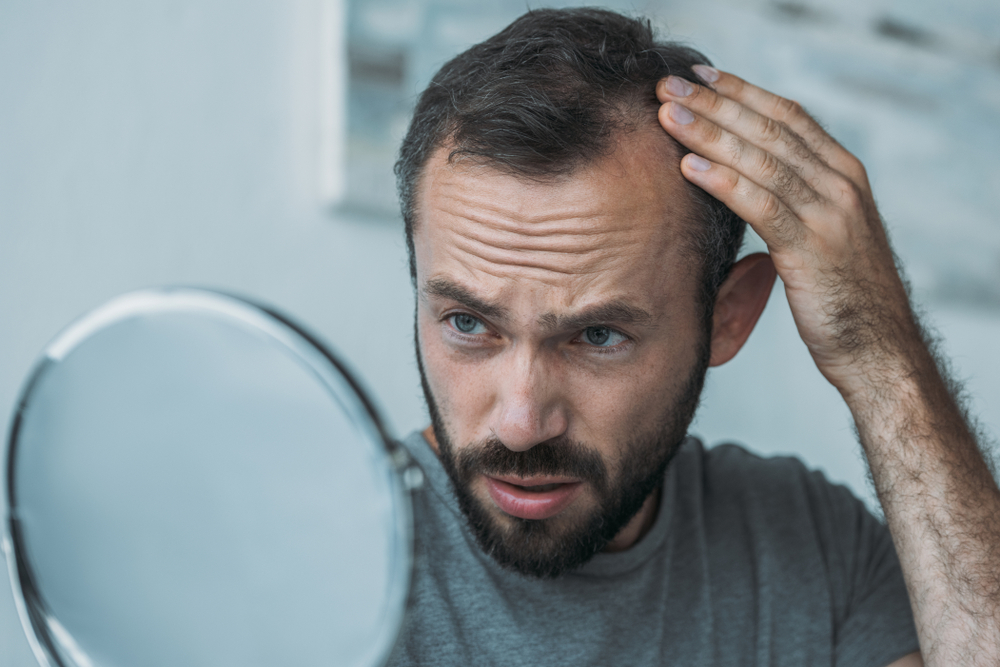Greasy hair
Greasy hair appears dirty, greasy, oily, shiny and often has an unpleasant odor.
Individuals who have greasy hair often also have other areas of the skin (nose, forehead, chin) that are quite greasy (called “seborrheic” skin).

Scientific collaboration between Professor Marco Toscani and Dr. Pasquale Fino, Chair of Plastic, Reconstructive and Aesthetic Surgery, Umberto I Health Center – “Sapienza” University of Rome.
Seborrheic hair loss is a form of premature hair loss that generally afflicts men in their youth (onset between 20 and 30 years of age), mainly affecting the frontal region and the crown. The cause, as the name of the condition suggests, is related to an excess production of sebum that provokes or accelerates hair loss. The symptoms that accompany seborrheic hair loss are itchiness, scalp pain and greasy dandruff that flakes.
Seborrheic hair loss is a form of premature hair loss that generally afflicts men in their youth (onset between 20 and 30 years of age), mainly affecting the frontal region and the crown. The cause, as the name of the condition suggests, is related to an excess production of sebum that provokes or accelerates hair loss. The symptoms that accompany seborrheic hair loss are itchiness, scalp pain and greasy dandruff that flakes.
Excess sebaceous gland activity is caused by hormonal imbalances or by an enzyme named 5-alpha reductase, which converts testosterone into dihydrotestosterone (DHT). The quantity of these converting enzymes and receptors that capture the androgens (testosterone) present on the scalp varies from case to case and influences the amount of sebum that is produced. The seriousness of the seborrheic hair loss depends on how the enzymes and receptors are distributed on the scalp.
Both in men and women, the levels of 5-alpha reductase are much higher in follicles in the temporal, frontal and crown regions than in those of the parietal and occipital areas. The difference lies in the number of receptors in the follicles, which in women is much lower than in men, meaning that they are less subject to seborrhea and greasy hair. In women the defect may nevertheless occur and is generally related to hormonal or digestive disorders. For this reason, in the presence of hair loss accompanied by seborrhea, it is not easy to understand up to what point DHT is the common cause of both phenomena and at what point, in turn, the excess sebum becomes a relevant cause of the hair loss due to its specific ability to obstruct the hair follicles, thereby altering hair growth.
In practical terms, this translates into cases of androgenetic hair loss overlapping and coexisting with seborrheic hair loss. The components of sebum (cholesterol, triglycerides, free fatty acids, squalene and sphingosine) cause an acidification of pH and therefore a metabolic disturbance and cutaneous cell turnover. Moreover, altered levels of sphingosine, an amino alcohol that controls bacterial proliferation, worsen the situation leading to a condition of seborrheic dermatitis.
Another cause of this disease seems to be related to fungus of the Malassezia genus, in particular Malassezia furfur (previously known as Pityrosporum ovale) and Malassezia globosa, present in notable quantities in areas affected by seborrhea. However, no specific relationship with this fungus has been proven yet. An increase in cell multiplication can be observed in the affected areas. The production of sebum does not increase but changes its composition, thus irritating the scalp. Furthermore, the hair can become frizzy, messy, non-uniform and above all very oily. The condition can also involve the face (near the nose, mouth and eyebrows) and the auricle (outer ear). The basic treatment consists of trichological treatments aimed at removing excess sebum thanks to their hygienic and regenerating properties. Low frequency laser, with its hygienic and antibacterial properties, is also very useful for revitalizing the scalp, thereby supporting metabolic activity in hair follicles and bulbs.
Although accompanied by the risk of possible side effects, finasteride may be used as a pharmaceutical therapy.
Greasy hair appears dirty, greasy, oily, shiny and often has an unpleasant odor.
Individuals who have greasy hair often also have other areas of the skin (nose, forehead, chin) that are quite greasy (called “seborrheic” skin).
Changes in the hair shaft lead to deterioration with the appearance of ruined or damaged hair.
In healthy hair, the cuticle is whole, with overlapping shingles. Hair with whole ends appears shiny, elastic and brushes easily.
La psoriasi è una frequente dermatosi cronica eritemo-squamosa con squama tipica (psoriasica), circoscritta o diffusa.
La psoriasi è un problema del cuoio capelluto non annoverata tra le cause che comportano la caduta dei capelli.
The scalp is an ultra-specialized area of the skin, where hair is anchored. Like other hair, also the hair on the scalp originates from a hair follicle, called a bulb.
The phenomenon of split ends, also called trichoptilosis, is a hair problem that depends on an alteration of the hair shaft with concurrent modification and deterioration of the structure, form and physiology of the hair.
The term Telogen Effluvium was introduced for the first time by Kligman (*) in 1961 to introduce an acute hair loss of benign origin that follows an intense and short period of stress of different types. Subsequently, Rebora (**) introduced the concept of chronic Telogen Effluvium.
Nossos especialistas te ajudarão a encontrar o tratamento mais adequado às suas exigências.
Agende uma consulta com nossos especialistas e conheça todos os tratamentos CRLAB.
Nossos especialistas estão prontos para encontrar a solução ideal para você.
NOSSAS SOLUÇÕES CRLAB, especialistas no bem-estar dos cabelos e do couro cabeludo
O método mais eficaz no combate à calvície. Recupera os cabelos de modo espesso e natural, o que permite ao paciente recuperar a sua aparência original. Uma solução patenteada que integra cabelos virgens naturais nas regiões atingidas por falhas de fios e pela calvície: um sistema completamente personalizado que garante funcionalidade e
uma aparência natural.